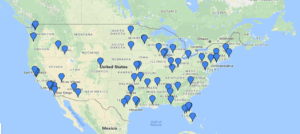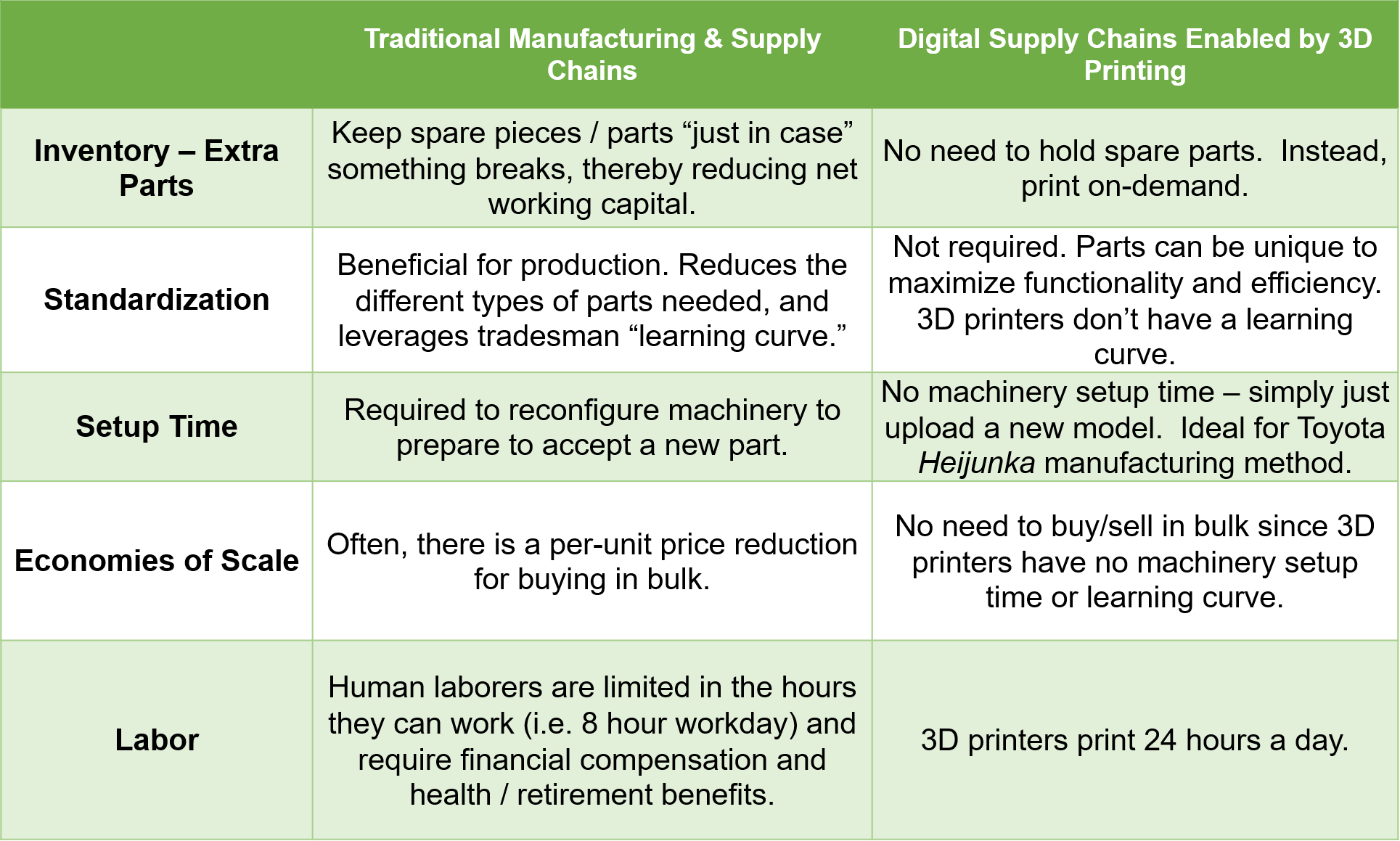What Can Brown Print For You?

Instead of being disrupted by the 3D printing revolution, UPS has decided to disrupt itself.
UPS generates $48.9B of annual revenue in part by delivering over 18.3 million packages per day to customers all around the world [1]. An undisclosed portion of this revenue comes from storing parts in their regional warehouses and delivering on-demand to customers [2]. Additive manufacturing, also known as 3D printing, is an emerging technology that threatens to eliminate this revenue stream. Customers that can print their own thermoplastic and metallic parts would no longer need UPS’s inventory storage and delivery services. To counter this, UPS is disrupting itself by using 3D printing to create a fully digital supply chain, replete with on-demand production.
What is 3D Printing?
Traditional manufacturing methods involve starting with a raw material stock and then cutting, grinding, and drilling material away to create the desired shape. This type of manufacturing is “subtractive” because material is removed to obtain the desired shape.
3D printing is the opposite. After a computer-aided-drawing (CAD) model is sent to a 3D printer, raw material in powder form is printed onto a substrate, creating the first 2D layer. Then, the next layer is printed on-top of the previous one. These 2D cross sections are built upon each other until a 3D part is created. Figure 1 provides an overview of a metallic 3D printing process. Although 3D printing enables engineers to create parts that are lighter, stronger, more resilient, and more thermodynamically efficient, the most disruptive enabler of the technology is the ability to create a digital supply chain.

3D Printing’s Effect on the Supply Chain
Traditional manufacturing processes and supply chains are governed by numerous principles, including standardization, economies of scale, employee learning curves, and machinery setup time. 3D printing removes these constraints.
The vision for UPS is a 100% on-demand digital manufacturing and supply chain. After customers upload their model and place the order, the order will automatically enter the printer queue, the part(s) will be made, boxed, and loaded onto a truck. But with the 3D printing sales growing 34% annually for the past three years, will UPS be able to fend off competitors and remain a market leader [4]?
Strength in Numbers

UPS’s Advantage
Making parts could provide a massive new revenue stream for UPS. However, the differentiator for UPS is not in printing the parts, but is in assembling a database of thousands of standard parts/pieces and consisting of SAP’s customers’ unique parts. The ability to digitally manage and produce inventory for customers is a high barrier to entry for competitors.
What Should UPS do Next?
UPS’s first-mover advantage and corporate partnerships will sustain their lead for a while. But, to help customers use their service, UPS should develop a software tool to help customers quantify the savings from switching to just-in-time production. Outside of the aerospace industry, who has leveraged the benefits of 3D printing, industries are often deterred by the expense of 3D printers, especially metallic printers that cost up to $500,000. For UPS, presenting the holistic cost-reduction picture of reduced inventory costs, less raw materials, improved product design capabilities, and improved quality* may help prospective customers switch to their service.
*Quality improvements can exist since the material properties can be evaluated at the molecular level after each layer of printing. This in-situ isn’t possible with castings, forgings, and many other manufacturing methods.
Setting Expectations
I would be remissed if I didn’t point out the challenges ahead. 3D printing is still a developing technology. UPS has used it primarily for plastics to make prototypes and small, non-critical parts. Certain improvement areas for the technology are reducing the time to print from multiple hours to less than an hour and reducing the cost of the raw material powder, especially for metals. But, the benefits of 3D printing and the effect on supply chains will continue to drive investments into the field. UPS has made a big bet. Only time will tell how fast new customers will find the technology to be economical. The real question is, “What can UPS Do Print for You?
Word Count: 794




I wonder if this bold move by UPS is the right one. I understand there is value in trying to prevent being disrupted by a new entrant, but I think this move is especially risky. Besides the obvious focus dilution that UPS will face for entering a business outside its core, I believe the 3-D printing industry is facing stronger than expected headwinds in its nascent stage. It seems to be trapped in a place where it is too dependent on traditional manufacturing to lift off and, apparently, it hasn’t gathered the necessary momentum to accelerate its path down the learning curve and become an economically competitive alternative (1). Until that happens, UPS’s clients won’t have enough incentives to demand the new 3-D printing service, and UPS is at risk of holding onto a yet-impractical, potentially money-losing, service.
(1) Newsweek, “The 3-D printing bubble may have burst”,” http://www.newsweek.com/2016/06/24/3d-printing-makerbot-stratasys-469704.html, accessed November 18, 2016
3D printing offers many opportunities going forward. As of now it is mainly used for prototype manufacturing considering scalability issues , which will go down as cost of print material goes down. An additional advantage of 3D printing is that it reduces barriers to entry in manufacturing. 3 D printing can help small scale manufacturers enter large scale market. 3 D printing techniques helps manufacturers with unique designs to develop a competitive edge. The only challenge as of now is to develop materials which when 3D printed have comparable properties as of a traditionally manufactured material.
This article from Mckinsey establishes 3D printing opportunities and market potential
http://www.mckinsey.com/business-functions/operations/our-insights/3-d-printing-takes-shape
Hey Carl – Thanks for this post! This is an interesting extension of UPS’ business model, and I could see the potentially for significant profits to the company in the short term. One concern that comes to mind however is the impact of a long decline in the price to 3D print. Already, we’ve seen falling prices as the technology has improved (http://www.zdnet.com/article/promising-trend-for-innovators-3d-printer-prices-are-falling/). As with traditional printing, it used to be so expensive that consumers and companies outsourced print jobs. However, as prices fall, and people can acquire a relative fast printer for under $100, the need for a middleman service became irrelevant. This is quite a capital intensive business, I worry deeply about UPS investing too heavily in technology that will soon be outdated to provide a service that will be irrelevant.
Love to read about 3D printing which is also extensively used in product development to test new design ideas! The reason it’s such a fantastic technology in my view is that it’s incredibly dynamic and fast. But as 3D printers become more affordable, accessible and easy to operate, I agree with Caroline’s concerns. 3D printers will eventually become as common as flat-screen TVs, microwaves or computers (https://www.makerbot.com/products/3d-printers/), with companies and consumers experimenting to create and design their own concepts and ideas. This trend will most likely radicalize how companies manufacture products without middle-men such as UPS and how we shop as consumers. This article (http://www.businessinsider.com/3d-printing-future-2012-103D) highlights the fact that very soon now “owning a 3D printer [will] mean no longer having to drive to the store to buy something manufactured in China, put on a boat, loaded into a truck, and dropped on a shelf.” Printers are definitely a powerful tool to improve products and services but in no way will they remain a competitive edge for UPS unless the company can leverage them to offer really cheaper product options and reduce friction linked to the convenience of buying the part.
Very interesting post! I did not know that UPS was investing in this. It makes some sense for a company like UPS to try to make this work, but I am quite skeptical about whether they will pull it off. There are so many 3d printing start ups out there right now, and I imagine that it will be hard for UPS to compete in the long run as 3d printing becomes a commoditized business. In the even longer term, eventually every business will have their own 3d printers, as will individuals in their homes. It doesn’t make sense to have something produced and shipped if you can cheaply and quickly make one on site and on demand.
I really question whether or not 3D printing or 3D printed parts will become as ubiquitous as people expect. Outside of a few industries, 3D printing has grown dramatically slower than analysts have expected due in large part to the ecosystem around 3D printing not expanding as rapidly as it should (particularly accessibility to 3D modeling software – the popular software packages still cost thousands of dollars to use).
Another key point to consider is that though no true machinery set-up time is required, there is a lot of time required to prove out models. Often models are not designed properly for the specifications of a particular printer or the the material fed to the machine. Furthermore there are some parts that are impossible or inefficient to manufacture through additive manufacturing processes. I worry that the risk of being the first mover in this space will be dangerous for UPS given that it is so far outside their core business.
Interesting post, Carl! Agree with some of the previous posts on concerns around this new business segment being perhaps too far removed from UPS’ core competencies. I imagine even if 3D-printed parts does become a commodity market, there could still be benefits from economies of scale that individual companies may not want to invest in to achieve the necessary level of scale so UPS may have a value-added role if they consolidate enough demand to drive down prices.
My concern was how this might impact existing supplier relationships. I would guess that UPS is currently holding parts inventory from suppliers. In this new world, what happens to the parts suppliers? How UPS manages phasing out those suppliers while it works to replace them could create interesting challenges, especially if the suppliers opt out of using UPS as a midpoint in the supply chain and move to alternative logistics companies due to the competitive threat.
Hey Carl – very interesting post. While I understand a lot of the concerns posted above, I do think UPS’s move into this space has potential, given how much flux there is in this landscape and how important it is to continue to experiment, learn and reinvent with emerging technologies that could transform their traditional business model. UPS has a culture that encourages this, as demonstrated by their investment in the drone-maker CyPhy Works. In fact, competitors like DHL are also looking into this space to reform their supply chain with on-demand printing of parts and contends the view that 3D printers will be commonplace consumer goods in the medium term. Instead, they acknowledge the opportunity for logistics companies to provide that last-mile service and incorporate 3D-printing of parts at scale for small to medium manufacturers.
(See : http://www.dhl-usa.com/content/dam/downloads/g0/logistics/green_logistics_sustainable_logistics_study_en.pdf)
Positioning this endeavor with SAP is great, there is probably no better enterprise supply chain partner with the expertise, scale and reach of SAP and that in itself already gives them a massive edge to attract the right kind of customers and embed their services better. The only recommendation would be to perhaps use Singapore as a pilot hub and test-drive this business model with a few chosen clients and industries first to understand what the opportunities, limitations and constraints are in this space before undertaking significant investments.